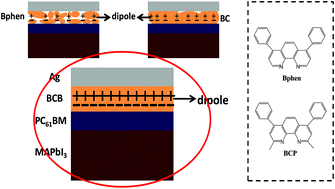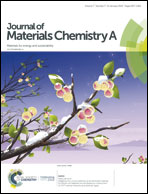Enhanced efficiency in perovskite solar cells by eliminating the electron contact barrier between the metal electrode and electron transport layer†
Abstract
Interface modifying layers (IMLs) play a pivotal role in the improved performance of perovskite solar cells (PSCs). Herein, we report a new IML based on Bphen:Cs2CO3:BCP (BCB), which is inserted at the interface of phenyl-C61-butyric acid methyl ester (PC61BM) and a Ag electrode. Consequently, the efficiency of PSCs is significantly improved by 5% (from 17.57% to 18.29%), mainly due to the increased open circuit voltage (VOC). It is revealed by ultraviolet photoelectron spectroscopy (UPS) that the work function of Ag is reduced from 4.68 eV to 3.90 eV, after being modified by BCB due to the formation of a strong negative interfacial dipole at the Ag/BCB interface. The decreased work function of Ag improves the ohmic contact between PC61BM and Ag, facilitating carrier extraction and suppressing the charge recombination at the interface of PC61BM and the Ag electrode. As a result, the reverse saturation current of the final PSC is decreased by approximately one order of magnitude, which is consistent with a larger VOC. Our work provides a comprehensive understanding of the interface between a metal electrode and an electron transporting layer (ETL), and hence paves a way towards better interfacial engineering and highly efficient solar cells.



 Please wait while we load your content...
Please wait while we load your content...